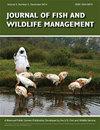Precision of Structures Used to Estimate Age and Growth of Apache Trout from the White Mountains of Arizona
IF 0.9
4区 环境科学与生态学
Q4 BIODIVERSITY CONSERVATION
引用次数: 0
Abstract
Obtaining reliable information on the age structure of fish populations is important for making conservation and management decisions. We sought to evaluate precision and reader confidence in age estimates from scales (two body locations), sectioned fin rays (pectoral, pelvic, anal), and sectioned sagittal otoliths from Apache Trout Oncorhynchus apache (n = 78 fish) sampled from the East Fork White River, Arizona, in 2017. Structures were aged independently by two experienced readers without prior knowledge of fish length. Each reader provided a confidence rating of zero (no confidence) to three (completely confident) as a measure of readability. Both readers were unable to estimate age from scales collected from the area just posterior to the insertion of the pectoral fin. Scales removed from an area just dorsal to the lateral line and posterior to the dorsal fin were used in all analyses. Percent exact agreement between readers was highest for scales and otoliths (> 72.0%) and lowest for fin rays (31.8–58.1%). Average confidence rating was highest for sectioned otoliths (mean ± SE; 2.1 ± 0.07), and lowest for anal fin rays (0.3 ± 0.06) and scales (0.7 ± 0.05). Consensus ages from otoliths were compared to the other structures. Percent exact agreement with otolith age was low and varied from 21.6–35.7% among structures. Similarly, percent agreement within one year was also low among structures (58.0–70.2%). Scales consistently underestimated age of age-4 and older fish (based on otolith age); whereas fin rays tended to overestimate age of younger fish and underestimate age of older Apache Trout. Although sectioned otoliths require lethal sampling, they produced the most precise age estimates for Apache Trout with the highest reader confidence. Dorsal scales may be a suitable non-lethal alternative to otoliths if ages for only young fish (age-3 and younger) meet study objectives.用于估计亚利桑那州怀特山脉阿帕奇鳟鱼年龄和生长的结构精度
获得有关鱼类种群年龄结构的可靠信息对于作出保护和管理决策非常重要。我们试图评估2017年从亚利桑那州东叉白河(East Fork White River)采集的阿帕奇鳟鱼(n = 78条鱼)的鳞片(两个身体位置)、鳍片切片(胸、骨盆、肛门)和矢状耳石切片对年龄估计的准确性和读者信心。结构是由两名经验丰富的读者独立老化没有事先了解鱼的长度。每个读者都给出了从0(不自信)到3(完全自信)的信心等级,作为可读性的衡量标准。两位读者都无法从胸鳍插入后方区域收集的鳞片来估计年龄。所有分析都使用了从侧线和背鳍后方区域取出的鳞片。读者对鳞片和耳石的准确一致性百分比最高(72.0%),对鳍片的准确一致性百分比最低(31.8-58.1%)。切片耳石的平均置信度最高(平均值±SE;2.1±0.07),最低的是肛鳍(0.3±0.06)和鳞片(0.7±0.05)。耳石的一致年龄与其他结构进行了比较。与耳石年龄的吻合率较低,各结构的吻合率在21.6 ~ 35.7%之间。1年内达成协议的比率也很低(58.0 ~ 70.2%)。鳞片一直低估了4岁和更大的鱼的年龄(基于耳石年龄);而鳍鱼倾向于高估年轻鱼的年龄,低估老阿帕奇鳟鱼的年龄。虽然切片耳石需要致命的采样,但它们为阿帕奇鳟鱼提供了最精确的年龄估计,读者的信心最高。如果只有幼鱼(3岁及以下)的年龄符合研究目标,背鳞可能是耳石的一种合适的非致命性替代品。
本文章由计算机程序翻译,如有差异,请以英文原文为准。
求助全文
约1分钟内获得全文
求助全文
来源期刊

Journal of Fish and Wildlife Management
BIODIVERSITY CONSERVATION-ECOLOGY
CiteScore
1.60
自引率
0.00%
发文量
43
审稿时长
>12 weeks
期刊介绍:
Journal of Fish and Wildlife Management encourages submission of original, high quality, English-language scientific papers on the practical application and integration of science to conservation and management of native North American fish, wildlife, plants and their habitats in the following categories: Articles, Notes, Surveys and Issues and Perspectives. Papers that do not relate directly to native North American fish, wildlife plants or their habitats may be considered if they highlight species that are closely related to, or conservation issues that are germane to, those in North America.
 求助内容:
求助内容: 应助结果提醒方式:
应助结果提醒方式:


